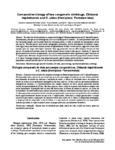Por favor, use este identificador para citar o enlazar este ítem:
http://www.alice.cnptia.embrapa.br/alice/handle/doc/1019873Registro completo de metadatos
| Campo DC | Valor | Lengua/Idioma |
|---|---|---|
| dc.contributor.author | SILVA, C. C. A. da | pt_BR |
| dc.contributor.author | LAUMANN, R. A. | pt_BR |
| dc.contributor.author | MORAES, M. C. B. | pt_BR |
| dc.contributor.author | AQUINO, M. F. S. de | pt_BR |
| dc.contributor.author | BORGES, M. | pt_BR |
| dc.date.accessioned | 2015-07-15T11:11:11Z | pt_BR |
| dc.date.available | 2015-07-15T11:11:11Z | pt_BR |
| dc.date.created | 2015-07-15 | pt_BR |
| dc.date.issued | 2015 | pt_BR |
| dc.identifier.citation | Pesquisa Agropecuária Brasileira, Brasília, DF v.50, n.5, p.355-362, maio 2015. | pt_BR |
| dc.identifier.uri | http://www.alice.cnptia.embrapa.br/alice/handle/doc/1019873 | pt_BR |
| dc.description | The objective of this work was to compare the biology of Chinavia impicticornis and C. ubica (Hemiptera: Pentatomidae), two species of stinkbugs that occur as secondary pests in soybean. Life table procedures were used for evaluating nymphs, and fecundity tables for evaluating adults, in order to establish the demographics of the two species. The two species have similar demographic parameters, and the development of immature stages, from egg to adult, had similar duration periods of approximately 30 days. In both species, eggs and second?instar nymphs were the stages with higher mortality. Total egg production did not differ between females of both species. Fecundity and survival curves for adults showed similar trends in both species. However, C. ubica had greater potential to increase its populations, since its fecundity parameters were significantly higher than those of C. impicticornis . Moreover, the generational time and the time required to double the population size were shorter in C. ubica . Prolonged longevity, long oviposition period, high fecundity, and the ability to rapidly increase their populations indicate that both species can become potential pests in favorable environments. | pt_BR |
| dc.language.iso | por | pt_BR |
| dc.rights | openAccess | pt_BR |
| dc.subject | Age-specific fecundity | pt_BR |
| dc.subject | Reproductive potential | pt_BR |
| dc.subject | Stinkbugs | pt_BR |
| dc.subject | Life table | pt_BR |
| dc.title | Comparative biology of two congeneric stinkbugs, chinavia impicticornis and C. ubica (Hemiptera: Pentatomidae). | pt_BR |
| dc.type | Artigo de periódico | pt_BR |
| dc.date.updated | 2016-03-22T11:11:11Z | pt_BR |
| dc.subject.thesagro | Glycine max | pt_BR |
| dc.subject.nalthesaurus | mass rearing | pt_BR |
| riaa.ainfo.id | 1019873 | pt_BR |
| riaa.ainfo.lastupdate | 2016-03-22 | pt_BR |
| dc.contributor.institution | CLEONOR CAVALCANTE ALVES DA SILVA, CENARGEN; RAUL ALBERTO LAUMANN, CENARGEN; MARIA CAROLINA BLASSIOLI MORAES, CENARGEN; Michely Ferreira Santos de Aquino, UnB; MIGUEL BORGES, CENARGEN. | pt_BR |
| Aparece en las colecciones: | Artigo em periódico indexado (CENARGEN)  | |
Ficheros en este ítem:
| Fichero | Descripción | Tamaño | Formato | |
|---|---|---|---|---|
| 19723962351PB.pdf | 595,58 kB | Adobe PDF |  Visualizar/Abrir |









